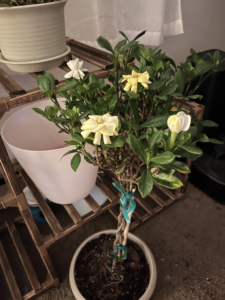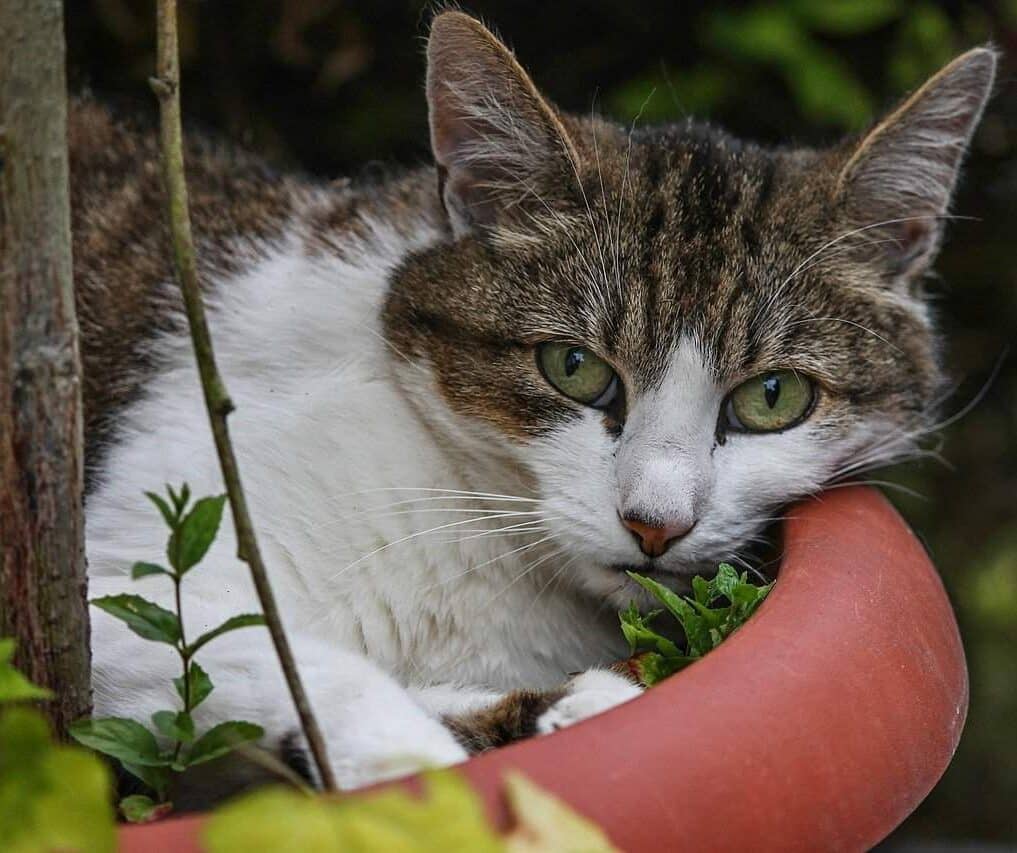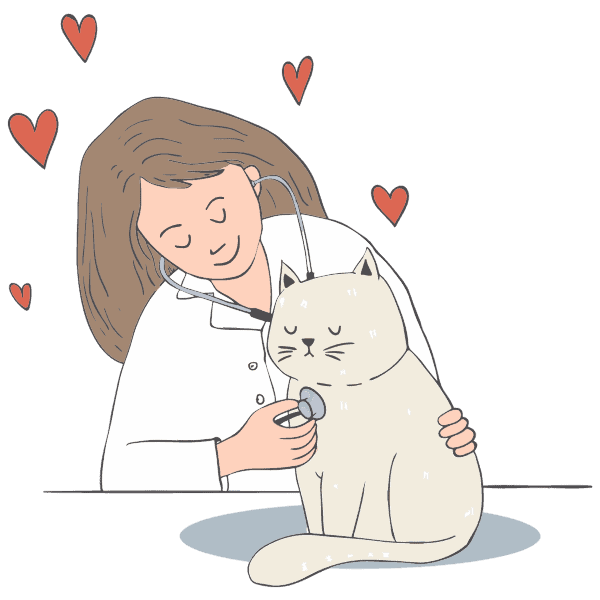Despite the symbolism of clarity, hope, trust, and regeneration, the white Gardenia flower happens to be a threat with toxic chemicals to your furry pets, especially cats.

So, if you are a cat lover and a fan of Gardenia, you must exercise extreme caution. Continue reading to know how you can treat and prevent it successfully.
Table of Contents Show
What Makes Gardenia Toxic to Cats?
According to ASPCA, there are 417 varieties of plants found toxic to cats, whereas 569 are recognized as non-toxic.
Lily, Cyclamen, and Sago Palm are some of the top names that aggressively harm cats.
Though Gardenia is safe for humans to touch and consume, some pets, such as dogs, cats, and horses, find it toxic.
Gardenia contains primary substances, including toxic geniposdies and gardenosides, that release the poisonous effect on cats.

Substances such as saponins, gardenoside, and geniposide also perform the same result.
These toxic components spread in all parts of Gardenia, such as flowers, stems, berries, and leaves, making the entire plant toxic to cats.
However, the plant reserves a large amount of toxins in ripe and unripe berries.
Once the toxins start processing in the body, your cat experiences mild to severe stomach distress. However, the first poisoning effect will be a bitter taste after a cat consumes any part of the plant.
Let’s know how toxic these substances are for your cat.
| Toxin Substances | Features | Toxicity Levels |
|---|---|---|
| Gardenosides | Contains hepatoprotective properties. | Mild toxic to cats |
| Crocetin | Releases carbon dicarboxylic acid which is a diterpenoid and natural carotenoid. | Highly toxic to cats |
| Iridoids | Includes neuroprotective, hepatoprotective, anti-inflammatory, antitumor, hypoglycemic, and hypolipidemic activities. | Nephrotoxic to cats |
| Glycosides | Shows up colorless, solid, amorphous, nonvolatile form. | Depends on the amount of consumption. |
Symptoms of Gardenia Poisoning in Cats
Cats are frisky with things at the house, and finding indoor plants, they jump into touching and smelling. But it does not violate Gardenia to poison them.
The poisoning symptoms start developing after they nibble any part of the Gardenia.
The intensity of poison symptoms depends on the size and kind of your cat.
Your cat starts experiencing a feeling of vomiting after it consumes a part of a plant. If it has already been a long time since eating, a cat may have stomach reactions.
Similarly, hives, commonly known as urticaria, can appear on your cats. It can cause pink, red, or flesh-colored itchy welts on the skin.

Besides, gastrointestinal discomfort is a common effect of Gardenia poisoning in cats.
Your cat may also suffer from nutrient insufficiency if they continuously nibble on leaves, flowers, or stems.
Here are two tables of Gardenia poisoning symptoms ranging from common to severe. Take a quick look and identify how your cat is going.
1. Common Symptoms of Gardenia Poisoning in Cat
Stiff walking and sweating are only a few common symptoms when a cat consumes Gardenia. Check more in the table.
| Common Symptoms | How to Check? |
|---|---|
| Abdominal discomfort | If the pet is unable to sit in one position, produces audible gut sounds, licks at flank. |
| Vomiting | Frequent lip licking, producing more saliva, resenting to eating food. |
| Diarrhea | The affected pet has frequent loose stool. |
| Hives | Red or pink rashes on the body. |
| Appetite disorders | Pet shows no desire to eat food anymore and includes loss of appetite and lethargy. |
| Weakness | If your pet is moving in weird way, is lethargic or hiding in a corner of the room, your pet might be weak. |
2. Severe Symptoms of Gardenia Poisoning in Cat
It is not good if a cat has already developed severe symptoms. The following table will tell you more.

| Severe Symptoms | How to Check? |
|---|---|
| Hypotension | Cat will produce pale or white gums, excessive urination and feels increased thirst. |
| Rapid heart rate | Adult cats feel around 120 -140 heart beats per minute. |
| Blindness | Vision loss that causes cat to be unable identify things. |
| Coma | Cat goes unconscious and unresponsive to sounds or touch. |
| Tremors | Cat shakes its head, legs, or entire body uncontrollably. |
| Dilated pupils | It often indicates that a cat is excited. |
| Seizures | Cat can have a twitching of eyelids or side of the face. |
Diagnosis of Gardenia Poisoning
Gardenia can take cats to unconscious if the toxins spread in high amounts in the body. So, this can cause severe incidents to cats if not considered.
You can confirm the poisoning symptoms as soon as possible; the following process will guide you.
1. DIY Diagnosis
- Examine the inside and around your cat’s mouth for plant debris and green leaves.
- Check if your cat is gasping in pain.

- It would be helpful to notice the vomit.
- You can also check if a cat is expelling stool frequently.
- Pink and red itchy bruise on the body also helps to confirm the symptoms.
2. Veterinarian Diagnosis
Take out your cat with the Gardenia plant to your nearest veterinarian. Also, bring some samples of plant parts, such as leaves, flowers, or stems that a cat has chewed and expelled.
Your veterinarian will perform a complete physical check-up such as overall appearance, health statistics, reflexes, stature, and belly palpation.
Similarly, you need to bring your cat’s medical history as your veterinarian might require further information about their previous records, such as past diseases, vaccines, and appetite level.
Likewise, the professional may also question if you’ve noticed any symptoms, when they are ingested, and how much they have ingested.

Since your cat’s organs are exposed to the poison, the veterinarian will conduct various tests such as a blood urea nitrogen(BUN), a urinalysis, creatinine (CREA), blood chemistry analysis, etc.
They may also go for the cat’s glucose and blood gas levels to determine the amount of poison spread in the body.
It is also essential to do an x-ray of the abdomen to figure out the impact of poison on the cat’s body. If needed further, an ultrasound or CT scan will be on-demand.
Treatment for Gardenia Poisoning in Cat
Cats may get themselves into tricky situations due to their inquisitive nature. Due to the ingestion of the poison, your cat’s kidney and liver may be vulnerable.
So, whenever you feel your pet has been poisoned or feel an urgency for your cat, watch out for treatments.
1. First Aid Treatment
- If you find your cat poisoned, make it calm down first.
- If your cat is unconscious or lying down, transfer your cat to a well-lit and ventilated location.
- Decontaminate the mouth by rinsing it with clean water if you find chewed parts of the plant.

- Do not feed your cat any foods, such as milk, salt, and oil, until properly diagnosed.
- Use activated charcoal to decrease the effect of the poison on the intestine if found a vomit. Give your cat 1 gram of dry powder per 1 pound of body weight.
- In addition, ensure your cat drinks water freely and fully to reduce the chance of organ damage.
- Provide your cat with first aid before the health worsens.
Here are some recommended first-aid kits for your poisoned cat!
| First Aid Brands | Included Components |
|---|---|
| Adventure Medical Kits | Sterile bandage materials, common medications, waterproof DryFlex bags, and essential tools. |
| RC Pet Products | Gauze rolls, pads, bandage, patch adhesives, exam gloves, scissor, emergency blanket saline solution, etc. |
| American Pet Supplies | sterile gauze pads, scissors, adhesive bandages, medical tape, hand cleansing wipes, disposable gloves, etc. |
Caution: The following steps are only general procedure for a poisoned cat. So, feel free to consult your vet before you conduct any experiment with your cat’s health.
2. Veterinarian Treatment
- If the vets figure out that your cat’s symptoms are not severe, they will focus on treating his pain and allowing the poisons to exit his system.
- Similarly, doctors will provide sucralfate and kapectolin to protect the stomach’s lining and prevent the issues such as diarrhea and vomiting.
- However, if the case is severe, it may initiate your cat to vomit to flush out the remaining poison in its system. The vet may give your cat a 3% hydrogen peroxide solution.

- Similarly, the vet may also provide your cat with activated charcoal, which will work to absorb toxins that have not reached the bloodstream.
- If your cat’s symptom is constant vomiting, the doctor may administer fluids through Intravenous therapy (IV) to hydrate your pet and keep his electrolytes in check.
- A doctor can provide antioxidants, homeopathic medicine, and other supplements for your pet’s health.
- In addition, if there are no signs of improvement after the treatment, your cat will end up spending the night at the hospital.
While treating the poisoned cat, the following medication can also help your cat to catch a recovery faster.
| Medicine | Dosage | Purpose |
|---|---|---|
| Kapectolin | 0.5 ml to 1.0 ml per pound (1 to 2 ml/kg) | Protects the stomach's lining. |
| Hydrogen peroxide solution | 1 teaspoon per 10 pounds of weight | Induces vomiting. |
| Activated charcoal | 1-5 g per kg of weight | Lessens the effects of poisoning. |
| Sucralfate | 1/4 to 1 gram per pet | Treats ulcers in the GI tract. |
Disclaimer: The mentioned supplements are only for educational purposes. Do not feed your cat until a professional vet finishes checking up on cat health and allows the prescriptions.
If you are unable to call your nearby or local veterinarian, you can contact the following helplines.
Recovery of a Poisoned Cat
The prognosis for plant poisoning in pets, including cats, depends on time and the amount of toxins involved.
The sooner your cat gets medication, or the sooner treatment begins, the lesser time the toxins find a way to spread through the body.
In most cases, 25% of poisoned pets successfully get recovered within two hours.

The effect of poison usually lasts up to 12 to 24 hours after the consumption of Gardenia.
Thus, your veterinarian might ask you to continue treatment for your cat to ensure its vital signs are stable and healthy.
Within 2 weeks, your cat will only exhibit slight symptoms with higher chances of recovery.
Ensure to consult your vet about the diet the cat should intake to better their health.
In addition, while your cat heals, your veterinarian may prescribe a softer diet with lots of water.
How to Prevent Your Cat from Eating Gardenia?
Due to their inquisitive nature, your cat is prone to go near or nibble anything that catches their eye.
However, such action can be harmful to the cats and give rise to various issues.
Here are some ways you can create a safe environment for your cat and their betterment:
- Place a tin foil or plastic carpet to protect your cat’s invasion into the plant area. The texture of the foil makes your cat uncomfortable, causing them to stay away from the plant.
- Place your poisonous plants inside the terrarium to protect your plant and cat.

- Cats are not a big fan of the citrus smell. So, you can spritz diluted lemon juice or orange oil directly onto the foliage.
- You can also make a handmade or homemade repellent spray. Create a solution of one part of vinegar to three parts of water and spray it on the leaves.
- If you have repellant, sprinkle it around the perimeter of your plants.
- Cultivate Cat Grass: Plant cat grass to keep cats away from other green plants.
- You can also place your toxic plants in a hanging basket to keep such plants away from your cat’s paws.
Conclusion
Gardenia is not as friendly to your pet as it looks with its snow-white flower and smooth green leaves.
With its leaves, flowers, and stems, the plant injures your cat if it consumes. So it is better to create some distance between your feline friend and Gardenia.
Whenever you feel an urgency for your poisoned cat, instantly take action rationally without performing hypertension.
After reading this all, I am sure that you can easily deal with poisonous Gardenia in your cat.
Keep your cat safe and grow a healthy plant!


